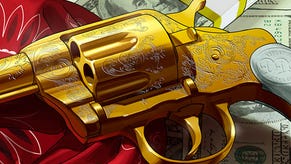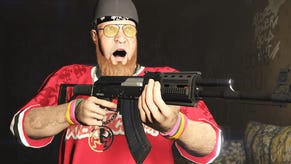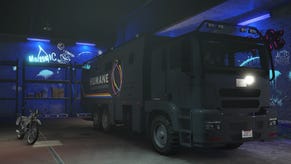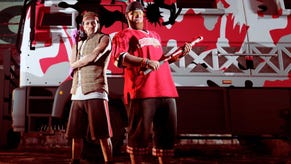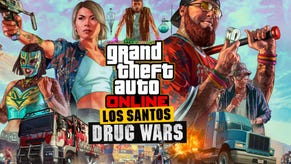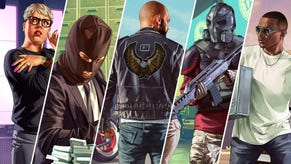10 Years Ago, San Andreas Closed the Curtain on Grand Theft Auto's Gleeful Mayhem
Rockstar's final installment in the GTA3 trilogy is huge, ambitious, and kind of a mess. But it sure knows how to have fun.
This article first appeared on USgamer, a partner publication of VG247. Some content, such as this article, has been migrated to VG247 for posterity after USgamer's closure - but it has not been edited or further vetted by the VG247 team.
My greatest memory of Grand Theft Auto: San Andreas involves a stolen tank and 25 minutes of absolute mayhem.
I drove backwards at top speed, firing away at the swarms of approaching authorities who typically frown on civilians borrowing military equipment. Somehow, I was invincible, but I didn't ask any questions—and when my spree ended, I had enough cash to perpetually bankroll the many sordid activities available to me in the game's sprawling world. That experience, to me, perfectly encapsulates the "make your own fun" nature of classic Grand Theft Auto—a quality Rockstar's pulled back from with recent installments.
Like tens of millions of others, the 2001 release of Grand Theft Auto 3 had me hooked. I didn't make a whole lot of progress, but the promise of exploring a fully rendered world instead of discrete levels made mundane acts like driving down unremarkable city streets oddly compelling. The following year's Vice City took the form of an '80s-themed expansion pack instead of a proper sequel, but the addition of helicopters, the chance to own property, and an unbelievably great soundtrack fully justified its existence. It wouldn't be until 2004's San Andreas, though, that I began to treat GTA as more than just a toy: In terms of stuff to do, this third take on the GTA formula practically feels like an MMORPG.

Empty a bag of Halloween candy on the floor, and you'll have a perfect visual metaphor for San Andreas' design. All of your favorite flavors are there, so long as you avoid biting into the Necco wafers and individually wrapped bundles of pennies (a mainstay of any neighborhood populated by senior citizens). There's no sense of order to it, but there doesn't have to be: You're free to zero in on whichever chunk looks the most appetizing.
San Andreas is a very busy game, even if it doesn't need to be. GTAIV wisely streamlined much of its predecessor's messiness, which began to approach The Sims' level of micromanagement. Protagonist CJ has to eat, work out to stay in shape, and build proficiency in the many categories of weapons and vehicles available—even though the terminology is absent, Rockstar essentially created an urban RPG with San Andreas.
Above all, the many distractions make San Andreas the standout installment of the GTA series: If you don't feel like finishing the story missions, the game offers no shortage of ways to spend your time. CJ can gamble via a handful of casino games, play a round of pool, shoot some hoops, hop into a lowrider for a rhythm mini-game, date one of several available women, pull some B&Es, perform delivery missions, go to flight school, and take part in the several returning vehicle-based side missions, from extinguishing fires to playing Rockstar's interpretation of Crazy Taxi. But San Andreas' massive and varied environments made doing absolutely nothing its own reward: If you want to relax, there's no better way than cruising through the hilly wilderness at night with the game's country station blasting away the timeless hits of Juice Newton.
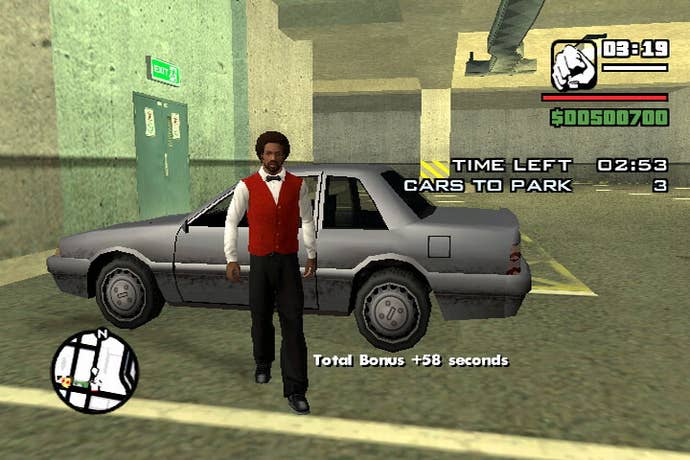
It should be noted that San Andreas could be the last triple-A game to predominantly feature a non-white cast of characters—though Telltale's The Walking Dead certainly excels in this area. Though we've made a miserable amount of progress over the past decade—most game protagonists remain white, stubbly wisecrackers—San Andreas proved the viability of veering away from conventional wisdom. Of course, it helps that GTA's reliance on pastiche and parody filled San Andreas with plenty of references to movies like Menace II Society and Boyz n the Hood, giving their audience a way to access their story of Shakespearean drama filtered through modern gang warfare.
To be honest, if you try returning to San Andreas, don't be surprised to find that old magic nearly gone. Most games don't age very well, but in the case of Grand Theft Auto III and its sequels, they felt creaky and unreliable to begin with—but we forgave them, simply because they gave us so much to do. Since then, Saint's Row has risen to reclaim the elements Rockstar left behind: As GTA becomes more focused on spinning gritty tales and delivering extended character studies of various psychopaths, Volition's series retains the "anything goes" atmosphere, which isn't at all concerned with leaving a narrative impact. Of course, entertainment should strive to do more than provide meaningless fun, but, in 2004, Grand Theft Auto: San Andreas struck the perfect balance between silly and dramatic. What other game lets the protagonist mourn his drug-ravaged neighborhood, then blast off to do some jetpack-based sightseeing?
...And if The Hughes Brothers are reading, that would make for an amazing scene in whatever movie they're working on next.

